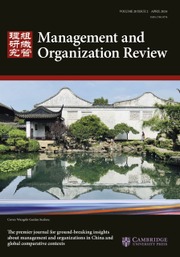Article contents
Revisiting the Springboard Perspective: Market-seeking Internationalization, Dynamic Capabilities, and Digital Transformation of Emerging Market Firms
Published online by Cambridge University Press: 04 July 2025
Abstract
This study explores the impact of market-seeking internationalization, including exporting, industry linkages with foreign multinational enterprises (MNEs) at home (e.g., being a supplier), and market-seeking foreign direct investment (FDI) on the digital transformation of large manufacturing firms from an emerging economy. I revisit the springboard perspective, arguing that serving international customers contributes to emerging market firms gaining dynamic capabilities and eventually leads to the adoption of digital technologies. A four-step mediation analysis, as well as path analysis using structural equation modeling, is employed to test the hypotheses. The results show that dynamic capabilities mediate the relationship between internationalization and digital transformation for exporting and market-seeking FDI, while industry linkages with foreign MNEs at home directly lead to digital transformation. With strategic asset-seeking FDI being controlled, our findings highlight that capability upgrading is not only about acquiring knowledge from outward internationalization but also through the endogenous growth path of learning by doing and knowledge acquisition from inward internationalization.
摘要
本文重温了跳板理论,论证了新兴市场公司服务于国际客户能促使其完成技术升级,而企业的动态能力在其中起到了至关重要的中介作用。研究结果表明,与跨国公司的产业关联可以直接引导新兴市场公司的数字化转型,而出口和对外直接投资则需要企业积累动态能力来实现数字化转型。在控制了新兴市场公司战略资产导向型投资的前提下,本研究的发现强调企业数字化转型不光需要寻求外部知识,也需要通过内生性增长和干中学来获取能力。
Keywords
Information
- Type
- Article
- Information
- Copyright
- © The Author(s), 2025. Published by Cambridge University Press on behalf of International Association for Chinese Management Research.
References
- 1
- Cited by

